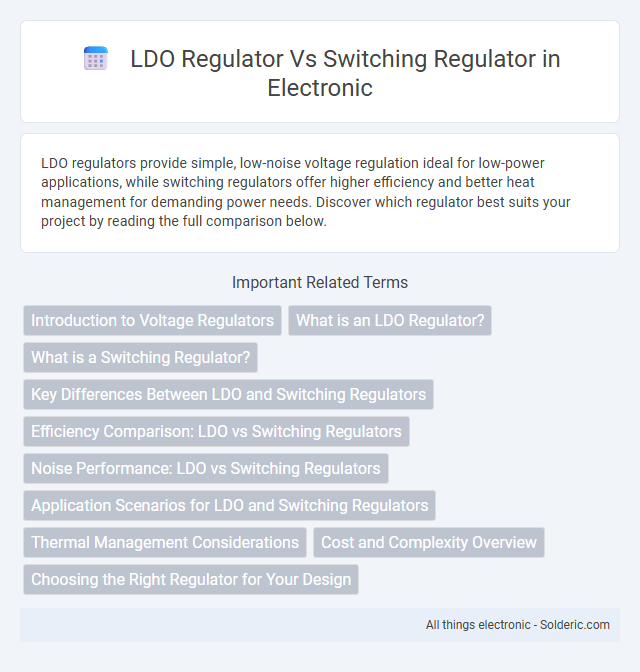LDO regulators provide simple, low-noise voltage regulation ideal for low-power applications, while switching regulators offer higher efficiency and better heat management for demanding power needs. Discover which regulator best suits your project by reading the full comparison below.
Comparison Table
| Feature | LDO Regulator | Switching Regulator |
|---|---|---|
| Operation | Linear regulation with pass transistor | Uses inductors, capacitors, and switches for voltage conversion |
| Efficiency | Low (typically 40-60%) | High (up to 90% or more) |
| Output Noise | Low noise and ripple | Higher noise and ripple due to switching |
| Size | Small and simple circuitry | Larger due to external inductors and components |
| Cost | Generally lower cost | Higher cost due to components and complexity |
| Heat Dissipation | High, due to voltage drop across transistor | Low, efficient power conversion |
| Applications | Low noise analog circuits, battery-powered devices with small voltage difference | Power-hungry devices, high efficiency power supply needs |
Introduction to Voltage Regulators
Voltage regulators maintain a steady output voltage despite variations in input voltage or load conditions, crucial for reliable electronic device performance. LDO (Low Dropout) regulators provide a simple, low-noise solution ideal for low-power applications with small voltage differences between input and output. Switching regulators offer higher efficiency by rapidly switching components on and off, making them suitable for systems requiring significant power conversion and longer battery life.
What is an LDO Regulator?
An LDO regulator, or Low Dropout Regulator, is a type of linear voltage regulator designed to maintain a steady output voltage with minimal input-to-output voltage difference, enhancing efficiency in low-voltage scenarios. Unlike switching regulators, LDOs provide low noise and ripple, making them ideal for sensitive analog and RF applications where signal integrity is crucial. If your project requires clean, stable power without complex circuitry, an LDO regulator ensures reliable voltage regulation with fewer components.
What is a Switching Regulator?
A switching regulator is an electronic power supply device that efficiently converts voltage by rapidly switching on and off, using inductors, capacitors, and diodes to store and transfer energy. Unlike LDO regulators, switching regulators maintain high efficiency across a wide input voltage range and varying load conditions, making them ideal for battery-powered applications and power-sensitive designs. Your choice between a switching regulator and an LDO depends on the importance of efficiency, heat dissipation, and output voltage stability in your project.
Key Differences Between LDO and Switching Regulators
LDO regulators provide low-noise and simple voltage regulation with minimal component count, making them ideal for low power and sensitive analog circuits. Switching regulators offer higher efficiency and the ability to handle a wide input voltage range by using inductors and switching elements, suitable for power-hungry applications. Your choice depends on requirements for efficiency, noise tolerance, and complexity.
Efficiency Comparison: LDO vs Switching Regulators
LDO regulators typically offer lower efficiency, often around 40-60%, because they dissipate excess voltage as heat, making them less suitable for high power applications. Switching regulators achieve efficiency levels of 80-95% by rapidly switching components on and off, minimizing energy loss and enabling better thermal performance. Your choice depends on the application's power requirements, with switching regulators preferred for efficiency-critical designs and LDOs favored for simplicity and low noise.
Noise Performance: LDO vs Switching Regulators
LDO regulators typically offer superior noise performance with low output voltage ripple and minimal high-frequency noise, making them ideal for sensitive analog and RF circuits. In contrast, switching regulators generate higher electromagnetic interference (EMI) and switching noise due to their high-frequency switching elements, which may require additional filtering for noise-sensitive applications. Choosing between LDO and switching regulators depends on the specific noise requirements, with LDOs favored for low noise and switching regulators for higher efficiency despite increased noise levels.
Application Scenarios for LDO and Switching Regulators
LDO regulators are ideal for low-noise, low-dropout voltage requirements such as powering sensitive analog circuits, RF modules, and battery-powered devices where efficiency is less critical. Switching regulators excel in applications demanding high efficiency, such as battery-powered systems, computers, and industrial equipment requiring substantial current while minimizing power loss. Your choice depends on balancing efficiency, noise tolerance, and complexity for the specific application scenario.
Thermal Management Considerations
LDO regulators produce continuous heat proportional to the voltage drop and current, requiring efficient heat dissipation through heat sinks or enhanced PCB thermal design to prevent overheating. Switching regulators operate with higher efficiency by rapidly switching on and off, generating less heat but necessitating careful layout to manage electromagnetic interference and thermal hotspots in inductors and switches. Proper thermal management in both types is critical to ensure device reliability and avoid thermal shutdown or reduced performance over time.
Cost and Complexity Overview
LDO regulators generally have lower cost and simpler design compared to switching regulators, making them ideal for applications requiring minimal external components and lower noise. Switching regulators, though more complex due to inductors, capacitors, and control circuitry, offer higher efficiency and better thermal management in high power applications. The overall system cost of switching regulators can be justified by energy savings and extended battery life in portable and high-demand devices.
Choosing the Right Regulator for Your Design
When choosing the right regulator for your design, consider that LDO regulators offer low noise and simplicity, ideal for low-power applications with minimal voltage drop. Switching regulators provide higher efficiency and are better suited for designs requiring significant voltage conversion or higher current output. Your choice depends on balancing requirements for efficiency, noise tolerance, and circuit complexity to optimize performance.
LDO regulator vs switching regulator Infographic

 solderic.com
solderic.com